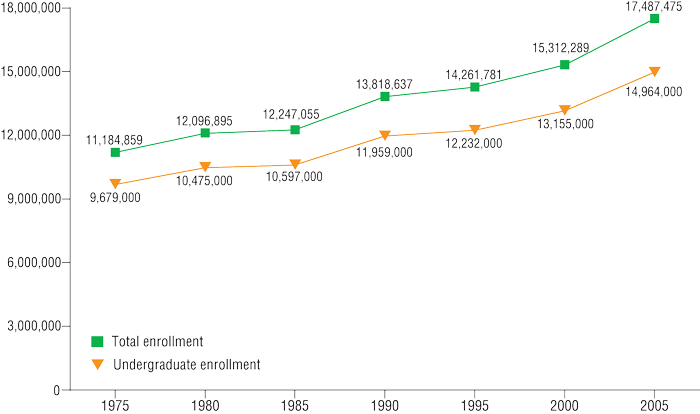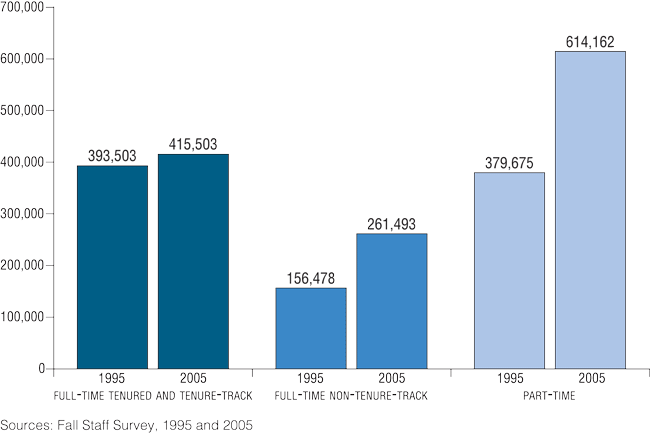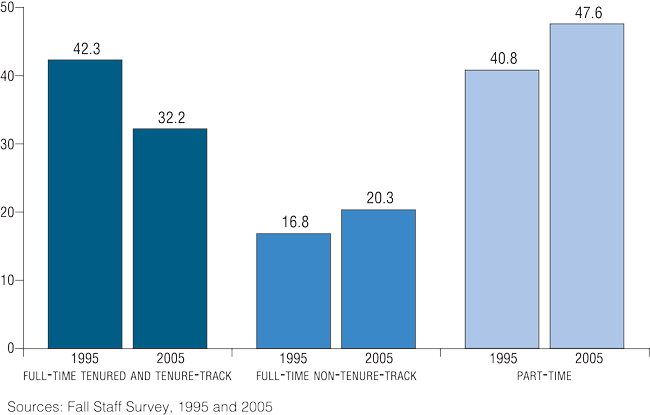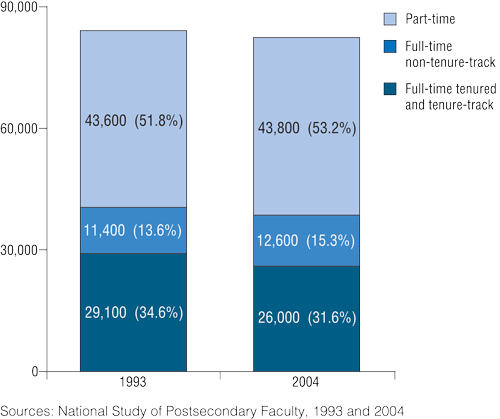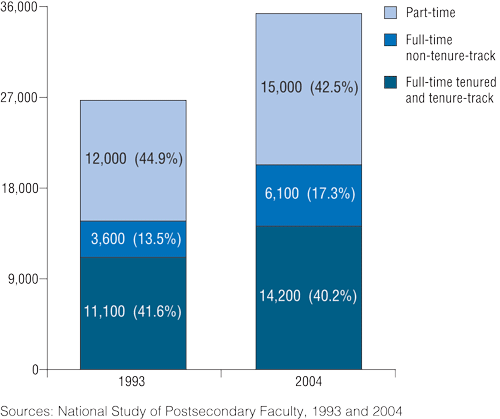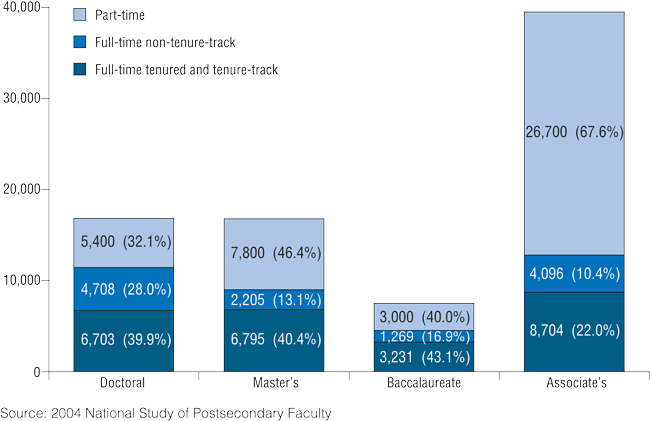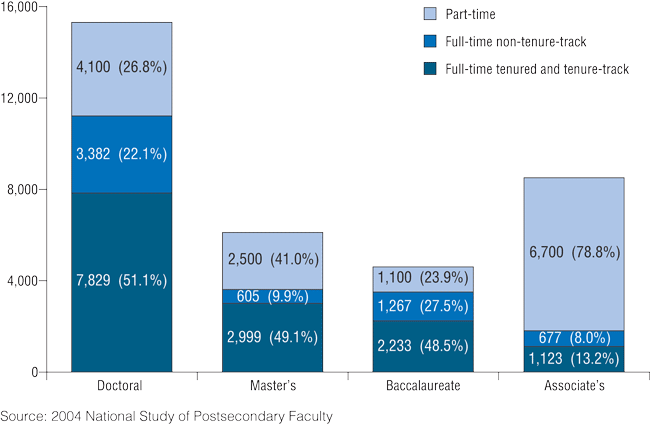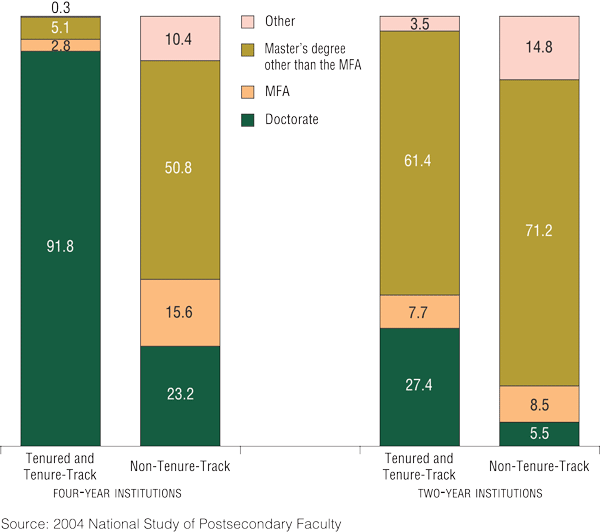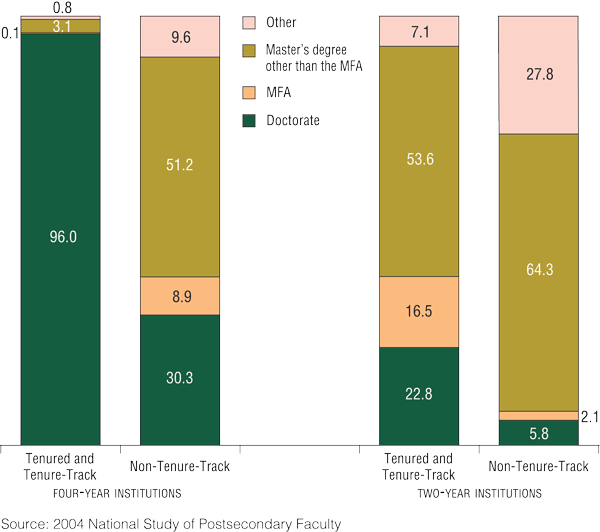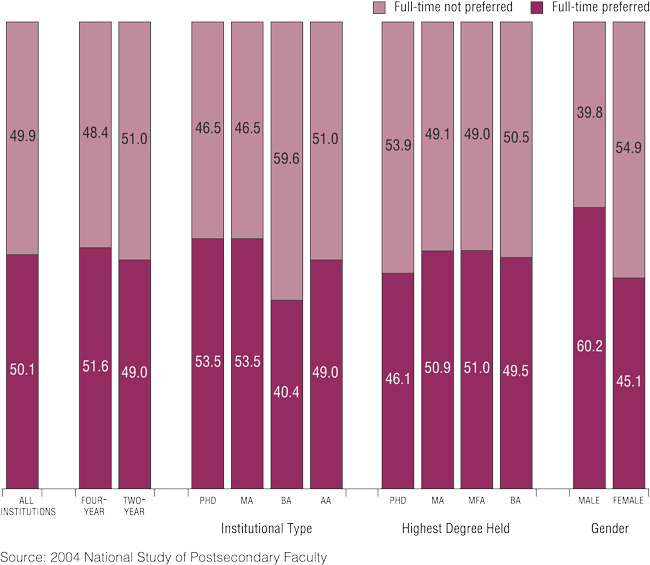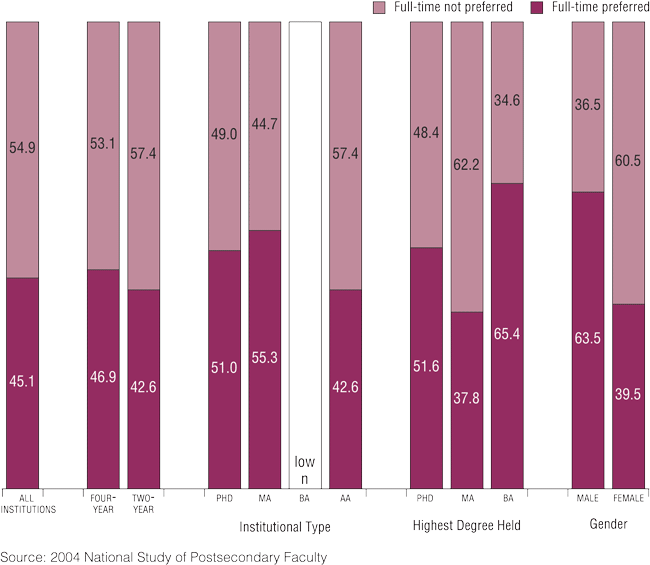The title of my essay was inspired by the fact that around the country, adjunct faculty members—and not exclusively those in English departments—have seized on The Scarlet Letter as an allegory of what they have experienced in their contingent appointments. Through media as diverse as buttons, T-shirts, signs on office doors, and digital and traditional scholarship, faculty activists have invoked the novel’s themes and appropriated its symbol of shame to expose the way that the adjunct faculty member recalls Hester Prynne. (Not surprisingly, it is the still predominantly female contingent faculty that is drawn most readily to the Hester Prynne analogy.)
Contingent faculty members and their supporters have found The Scarlet Letter to be a good conversation starter because its place in American culture makes it a useful point of reference for explaining contingency to nonacademic audiences. For example, my friend and colleague Sue Doe referred to the novel in her testimony before the Colorado state legislature in support of a bill—which passed—allowing multiyear contracts at state colleges and universities. She explained that “once a person has worn the Scarlet A for Adjunct for even two or three years, it becomes increasingly difficult to have any opportunity for a different kind of appointment.”
Faculty activists’ clever use of The Scarlet Letter in their advocacy represents an increasing awareness of the importance of accessibility in and to the movement for contingent faculty equity. I offer three strategies for making our communication more accessible to the wider audience we know we need to reach and thereby making it more effective. I’ve articulated them in language that we often use when we give feedback on our students’ essays, in part as a reminder that what we do is intricately connected to what we do for students. However, my suggestions are also the result of the effort by the New Faculty Majority (NFM) to construct our strategies intentionally, through constant reflection on the theory and process of change.
My suggestions are that we must revise the argument, tell the stories, and be attentive to language.
Revise the Argument
If you review the history of activism on behalf of contingent faculty members, it becomes clear that the fundamental argument for reform has always had as its primary warrant the immorality of exploitative practices. A good example of this rationale is the Wyoming Resolution of 1986, later adopted by the Conference on College Composition and Communication. It begins:
It is no surprise to me that the authors of this resolution were attuned to the injustice of contingent employment and sincere in their resolve to address it. They, and many of the activists before and since who have taken on this cause, have in common a highly developed, inspirational sense of justice and fairness. As a parent, I would be eager to have my children taught by professionals like them.
However, as a parent, I also understand that the appeal to justice and fairness does not always translate well into action. Not to say that justice and fairness should be abandoned, either as goals for which to strive or as principles by which to live. But if we are to achieve those goals and live by those principles, then sometimes we have to find different ways of thinking about and articulating them.
This is precisely what we have done at the NFM. The statement we lead with is not that contingent faculty working conditions are exploitative but that “faculty working conditions are student learning conditions” (see Osborn). We were not the originators of this slogan, but it is our operating principle. We use it not because we believe that faculty members are not exploited. Rather, we use it because one of the most important lessons we have learned in our short existence is that all the arguments we make about the need for reform of non-tenure-track faculty working conditions must be linked to the fundamental principle that students and faculty members both deserve access to quality higher education.
We learned this lesson through an interesting interaction with, of all entities, the IRS, which I’ve written about elsewhere (“Taking Heart”). The IRS was not convinced that advocating on behalf of contingent faculty members could possibly fit the definition of a public charity charged with advancing education. The agency didn’t get our unstated assumption (because it was unstated!) that education is a public good and that students are harmed when their teachers are not respected or supported.
Michael Bérubé reflected on this problem of assuming that an audience shares your understanding and your value system at our January 2012 NFM summit and in his MLA “From the President” column reflecting on the summit. He suggested that in communicating with those outside higher education, we have to be aware that
If we are going to make the case that the promise of higher education is undermined when seventy-five percent of the professoriat is exploited, then we need to lead with a conversation about that promise. To whom is it made? Who has access to it? Is it for faculty members too? How is the promise of higher education fulfilled? What are the conditions necessary for it to be fulfilled?
We soon found that others working on this issue were also coming to the realization that the argument needed to be revised. Adrianna Kezar, an associate professor at the University of Southern California and an NFM member, has refocused the conversation in her groundbreaking Delphi Project, whose participants include representatives from the MLA, NFM, all the faculty unions, and almost every sector of higher education, from administrators to accreditors to the Association of Governing Boards. By foregrounding research and practice that tie support for faculty members to support for students, the Delphi Project on the Changing Faculty and Student Success debunks the notion, still in vogue, that making all faculty positions contingent is somehow good for higher education.
I know that when contingent faculty members hear that educational quality is being invoked as an argument against contingency, their immediate and understandable fear is that the argument will be construed as an attack on their credentials, professionalism, and even character. (For that reason Bérubé requested that we consider solutions that do not devalue the work of non-tenure-track faculty members.)
In encouraging that we revise our argument to emphasize educational quality, I am saying not that statements about the exploitation of faculty members should be eliminated or downplayed but that, as a matter of rhetorical strategy, the idea of exploitation should be reframed. Exploitation as a violation of justice and fairness should not be separated from the concept of educational quality; the two should be fully integrated.
A practical program to reverse exploitative practices is not only consistent with but is in fact rooted in the fundamental purpose of education in and for a democratic society. Richard Moser, a historian, an NFM member, and a trusted adviser, articulated this idea well. At a meeting of the Coalition on Contingent Academic Labor in Chicago in 2004, he observed:
As Steve Street and I wrote, “[T]here are few more compelling definitions of the purpose and process of education. As every parent and every educator knows, there is no better—or more unforgiving—pedagogical tool than the power of example” (Maisto and Street 12).
Tell the Stories
My second suggestion for making our argument more accessible is based on what we so often tell our students when their papers have a great thesis but not enough evidence—or poorly organized and presented evidence—to support it. There are a number of stories out there and ways to tell them, yet too often the stories are not accessible. Sometimes we cannot make them accessible to one another, not because we are being proprietary about them but rather because we adjuncts, like our stories, are not organized enough. And by not organizing, we end up telling troubling stories. Consider, for example, that according to the American Federation of Teachers, “of the 10.4% of faculty positions held by members of underrepresented racial and ethnic groups, 7.6% are contingent—which means that 73% of underrepresented faculty hold positions that do not give them adequate wages or benefits, job security, or meaningful academic freedom” (Promoting 13).
We at the NFM have been working on telling stories effectively to legislators and policy makers about how contingency lowers the quality of education. We are tapping into demands for more information, like the Student Right to Know before You Go Act and the White House College Score Card.
Part of the NFM’s goal, then, is to be a national clearinghouse, a library, a hub, a center that provides activists with access to the stories they need and assists our fellow storytellers in making their arguments effective. Our summit aimed, in part, to make the point that organization is a fundamental principle of both social activism and effective communication. We wanted not only to present the stories but also to connect the storytellers. Connecting Joshua Boldt to Bérubé, for example, led to the launch of The Adjunct Project, which has been part of an unprecedented convergence of data collection efforts around adjunct faculty working conditions, along with the MLA’s Academic Workforce Data Center and the published findings of a survey by the Coalition on the Academic Workforce (CAW) of part-time faculty members (Portrait). The narrative power of the numbers that these projects reveal is awe-inspiring.
For example, at the college where I teach (at least, this semester), Cuyahoga Community College, the number of non-tenure-track faculty members went from 14.1% in 1995 to 77.7% in 2009 (10% part-time in 1995 to 76.3% part-time in 2009), according to the MLA’s Academic Workforce Data Center. Meanwhile, according to the CAW survey, annualizing contingent faculty compensation reveals that the difference, in terms of dollars and as a percentage, between what faculty members make and what people with the same level of education make working outside higher education ranges from $21,950 (65%) to $69,500 (310%) (Portrait, table 20).
The Delphi Project (which recently administered a survey to two national deans’ organizations that yielded revealing responses [see June]) has also been compiling research and stories of best practices to share. And the NFM Foundation in conjunction with the Center for the Future of Higher Education published a report based on our back-to-school survey of contingent faculty hiring practices (Street, Maisto, Merves, and Rhoades); it harnesses the narrative power of quantitative and qualitative analysis—numbers and stories—to explain how faculty working conditions affect student learning conditions. We framed the issue of quality around the student’s experience of being faced with a professor made invisible, powerless, and anonymous as well as around faculty experiences of either donating or being denied the tools and support that colleges should be providing.
Our survey, like the departmental checklist released in 2011 by the MLA Committee on Contingent Labor in the Profession (Professional Employment Practices), is a story-creating tool that all institutions and faculty groups should use in the pursuit of quality. Our finding is that from 30 to 60 percent of contingent faculty members get their teaching assignments with three weeks or fewer to prepare and are given scanty access to professional tools, from offices to parking passes, even though a significant number have taught at their institutions for years, even decades. This report is a powerful counternarrative to institutional claims of the need for flexibility and more managerial control.
We invoke the voices also of students and administrators. In 2008, the then vice president for human resources at the University of Akron, A. G. Monaco, declared, “Wal-Mart is a more honest employer of part-time employees than are most colleges and universities” (Jaschik, “Call”). More recently, community college students reported on a survey funded in part by the Gates Foundation that they are very much aware of what is going on and do not appreciate being shortchanged with ever-dwindling access to the teaching, advising, and mentoring that they want and need. In that survey, students said that introductory courses—the ones most likely to be taught by adjuncts and subject to the “just in time” hiring (“Just in Time”) we highlighted in our report (Street, Maisto, Merves, and Rhoades)—“are not offered in a way to help them succeed.” Faculty members “who offer support and guidance” are “in high demand” but “hard to come by” (Student Voices 2, 6). Research like this exposes the stark difference between institutional policies, which are self-serving, and activist arguments, which are student-serving.
Telling the story of how adjunct working conditions lower the quality of education, we focus on another important theme of the 2013 MLA convention: access for people with disabilities. The NFM’s acting research director, Marisa Allison, wrote a brief for the most recent newsletter of the GWU Heath Resource Center, an online clearinghouse on postsecondary education for people with disabilities. It explains how poor working conditions make it difficult for contingent faculty members to serve students with disabilities. As the mother of a child with Asperger’s and an instructor who has worked to help students with disabilities, I am committed to the story of how avenues of access—for contingent faculty members and for people with disabilities (and their families)—converge.
From testimonials on electronic discussion lists to documentaries to novels and artwork, the stories are out there in abundance. There is subversive fiction and humor: Alex Kudera’s Fight for Your Long Day, the Web site True Adjunct Tales, Doonesbury. There are true stories about adjuncts, like Doug Wright, a longtime instructor whose reduction to adjunct status caused him to lose health insurance just as he discovered he had cancer (Jaschik, “Uninsured Adjunct”), and Sissy Bradford, who was not offered classes to teach at the University of Texas, San Antonio, after she complained that crosses were being erected at the public university’s entrance (Schmidt). Others include Michael Dubson’s book Ghosts in the Classroom, L. D. Janakos’s YouTube series Teachers on Wheels, Debra Leigh Scott and Chris LaBree’s film ’Junct, and the online video Con Job: Stories of Adjunct and Contingent Labor. Our colleague Vanessa Vaile has been at the forefront of our social media efforts, singlehandedly curating the most comprehensive collection of stories about the contingent faculty experience that currently exists. She has connected so many storytelling activists to one another that she should have the title “national adjunct faculty organizer.” Appropriately, one of the sites she manages is called A Is for Adjunct.
Regarding the constant fear that focusing on educational quality will devalue or blame adjuncts, I suggest that unearthing, curating, and disseminating the stories of the adjunct experience is the natural antidote to the perception that the problem lies with the adjuncts and not with the system. Unlike the replacement referees used by team owners during the 2012 National Football League referee lockout (Heller), adjuncts are not incompetent. They are not fake professors; they are real ones. If they were really incompetent, the system would have collapsed ages ago.
Some people believe that the dedication and success of adjunct faculty members despite their working conditions should not be the theme of the stories of adjunct experience. Such heroic narratives, they contend, undermine the thesis that the quality of education is being negatively affected. As one administrator put it, if adjuncts are always surmounting the obstacles placed in front of them, then what incentive do institutions have to change their ways? My response to that question is that adjuncts should strive for professionalism and should tell the stories of what it takes to provide it—sometimes successfully, sometimes not—in the face of great obstacles. Our argument, supported by considerable research (see, e.g., “Resources”), concerns the structural inequality of the contingent system, not the individual quality of the instructors. The onus is on institutions, not instructors, to level the playing field so that a fair comparison among instructors can be made.
Be Attentive to Language
No matter how much we stress working conditions, some audiences will hear what one listener heard during a recent NPR show on adjunct faculty organizing on which I was a guest (“Adjunct Professors”). The listener asked, “So you mean that I’m paying for steak and getting hamburger? I’m not getting a real professor?” The response to that should be, “No, you are getting steak, but you need to call the health department, known as accreditors in higher education, to expose colleges’ lack of safe food-handling practices.”
Our job is to be attentive to language, both in conversations outside our communities and within them.
Here is another, perennial example. Many people focus on the problematic language of titles: adjunct, lecturer, and so on. We can take a lesson from Hester Prynne and make a badge intended to humiliate us into one that honors us. Instead of continuing to use words like adjunct and contingent, we might use the expression “extraordinary faculty” (Maisto, “Professor”). This idea came to me through a tenured friend at Georgetown University who refers to tenure-stream faculty members as “ordinary.” The term suggests that faculty work should be so essential to the institutional mission as to be unmarked linguistically. I like “extraordinary” for non-tenure-track faculty members because it communicates both the heroism necessary to teach well in the current system and the appalling nature of that system.
We should be attentive to language by getting involved in debates that involve language, especially definition. Many of these debates emerge around labor and employment issues and human resources, which Beth Landers addressed at the 2013 MLA convention. These issues are already on the radar screen of legislators and policy makers, under the umbrella of “misclassification of employees” (“Employee Misclassification”).
Three manifestations of this problem in higher education have been prominent recently, and we can use the expression “trying to have your cake and eat it too” to describe how colleges have manipulated definitions to derive the benefits of using their employees without having to incur the costs associated with using them. One cost is unemployment insurance. Colleges remind adjuncts in many ways that they have no expectancy of continued employment, yet these same institutions affirm to state unemployment agencies that their adjuncts have reasonable assurance of continued employment, legal language that denies adjuncts unemployment insurance. Exposing and correcting this abuse is the focus of the Steve Street National Unemployment Compensation Initiative. There has been attention to how the definition of part-time will affect what rights part-time faculty members will have under the Affordable Care Act. Colleges are beginning to cut adjunct hours to avoid providing adjunct faculty members with health insurance. In some instances, they are also redefining adjunct faculty work according to a formula that asserts that faculty members work only one hour outside class for every hour they teach.
Finally, looking at contingency from the human resources perspective brings up the ubiquitous but little understood definition of exempt versus nonexempt employees under the Fair Labor Standards Act. Exemption, like unemployment, is under the jurisdiction of the Department of Labor. The government provides exemption from rules for hourly wages and overtime but also recognizes the responsibility of the employee to exercise professional judgment that takes specialized training into account. Colleges exploit this definition, which at heart is a technical and cultural classification of faculty work as professional, to classify extraordinary faculty members one way for one purpose and a different way for another purpose—to the benefit of the institution, not the faculty member or the student. The MLA, as the leading association devoted to language and letters in higher education, ought to take a leading role in these language- and definition-dependent policy issues.
I don’t pretend to be a Hawthorne scholar, but I believe that The Scarlet Letter provides us with some powerful strategies for confronting contingency. How does Hester Prynne co-opt a symbol meant to shame her and reshape the argument over what her future should be? As my colleague Anne Wiegard has put it, Hester performs an act of resignification, finding a way to tell her story as she wants it told. She makes a beautiful A, altering the form of the letter artistically with vivid embroidery, interpreting red as the color of sacrifice and passion, and displaying the A prominently. Instead of rendering the letter on a small scale and trying to hide it, she embraces it and owns it.
Adjuncts and full-time contingent faculty members—extraordinary faculty members—are now the majority in the academic teaching workforce. It’s time for us, and for those with whom and for whom we work, to change the conversation from a legalistic and mean-spirited debate over who deserves to have access to education of the highest possible quality, either as a student or a faculty member, to consideration of how to ensure that the social contract at the heart of education is nourished and strengthened for the good of all, so that one day the scarlet “A for Adjunct” will, to paraphrase Hawthorne, “cease to be a stigma which attracts [higher education’s] scorn and bitterness, and becomes a type of something to be sorrowed over, and looked upon with awe, and yet with reverence, too” (305–06).
Works Cited
Academic Workforce Data Center. Modern Language Association. MLA, 8 Mar. 2013. Web. 19 July 2013.
“Adjunct Professors Unite: Labor Rights on College Campuses.” The Kojo Nnamdi Show. NPR. WAMU, Washington, DC, 1 Oct. 2012. Radio.
Allison, Marisa. “Thinking about Different Student Populations.” Heath Resource Center at the National Youth Transitions Center Newsletter (2012): 5–7. Web. 31 Dec. 2012. <http://www.heath.gwu.edu/assets/133/heath_nytc_2012_december_newsletter.pdf>.
Bérubé, Michael. “From the President: Among the Majority.” Modern Language Association. MLA, 30 Mar. 2011. Web. 30 Dec. 2012. <http://www.mla.org/blog?topic=146>.
Doe, Sue. “Testimony regarding Fisher Legislation As Provided to the House Committee on State, Veterans, and Military Affairs, Colorado General Assembly, on February 15, 2012.” American Association of University Professors Colorado Conference. N.p, 15 Feb. 2012. Web. 31 Dec. 2012. <http://aaupcolorado.org/2012/02/15/testimony-regarding-fisher-legislation-as-provided-to-the-house-committee-on-state-veterans-and-military-affairs-colorado-general-assembly-on-february-15-2012/>.
“Employee Misclassification as Independent Contractors.” Wage and Hour Division. United States Dept. of Labor, n.d. Web. 9 Aug. 2013. <http://www.dol.gov/whd/workers/misclassification/>.
Hawthorne, Nathaniel. The Scarlet Letter. New York: Dover, 1994. Print.
Heller, Jake. “The NFL Replacement Referees’ Six Worst Blown Calls.” Daily Beast. Newsweek / Daily Beast, 26 Sept. 2012. Web. 21 July 2013.
Jaschik, Scott. “Call to Arms for Adjuncts . . . from an Administrator.” Inside Higher Ed. Inside Higher Ed, 14 Oct. 2008. Web. 31 Dec. 2012. <http://www.insidehighered.com/news/2008/10/14/adjunct>.
———. “The Uninsured Adjunct.” Inside Higher Ed. Inside Higher Ed, 30 Nov. 2009. Web. 16 Sept. 2013. <http://www.insidehighered.com/news/2009/11/30/adjunct>.
June, Audrey Williams. “Deans’ Ideas about Hiring Adjuncts Differ from Reality, Survey Finds.” Chronicle of Higher Education. Chronicle of Higher Educ., 13 Nov. 2012. Web. 19 July 2013.
“Just in Time.” Investopedia. Investopedia US, 2013. Web. 9 Aug. 2013. <http://www.investopedia.com/terms/j/jit.asp>.
Landers, Elizabeth. “Human Resources: Employment Practices and the Future University.” The Presidential Forum: Avenues of Access: Non-Tenure-Track Faculty Members and American Higher Education. MLA Annual Convention. Sheraton Chicago, Chicago. 3 Jan. 2013. Address.
Maisto, Maria. “A Professor by Any Other Name.” Twenty-First Century Scholar. Twenty-First Century Scholar, 17 Feb. 2012. Web. 31 Dec. 2012. <http://21stcenturyscholar.org/2012/02/17/a-professor-by-any-other-name/>.
———. “Taking Heart, Taking Part: New Faculty Majority and the Praxis of Contingent Faculty Activism.” Embracing Non-Tenure Track Faculty: Changing Campuses for the New Faculty Majority. New York: Routledge, 2012. 190–204. Print.
Maisto, Maria, and Steve Street. “Confronting Contingency: Faculty Equity and the Goals of Academic Democracy.” Liberal Education 97.1 (2011): 6–13. Association of American Colleges and Universities. Web. 16 Sept. 2013. <http://www.aacu.org/liberaleducation/le-wi11/LEWI11_FacultyEquity.cfm>.
Moser, Richard. Campus Democracy, Community, and Academic Citizenship. Chicago Coalition of Contingent Academic Labor, 22 July 2004. Web. 31 Dec. 2012. <http://www.chicagococal.org/downloads/conference-papers/Richard-Moser.pdf>.
Osborn, Eliana. “Faculty Working Conditions Are Student Learning Conditions.” Chronicle of Higher Education. Chronicle of Higher Educ., 30 Jan. 2012. Web. 18 July 2013. <http://chronicle.com/blogs/onhiring/faculty-working-conditions-are-student-learning-conditions/30256>.
A Portrait of Part-Time Faculty Members. Coalition on the Academic Workforce. CAW, June 2012. Web. 19 July 2013. <http://www.academicworkforce.org/CAW_portrait_2012.pdf>.
Professional Employment Practices for Non-Tenure-Track Faculty Members: Recommendations and Evaluative Questions. Modern Language Association. MLA, June 2011. Web. 19 July 2013.
Promoting Racial and Ethnic Diversity in the Faculty: What Higher Education Unions Can Do. Amer. Federation of Teachers, n.d. Web. 16 Sept. 2013. <http://www.aft.org/pdfs/highered/facultydiversity0310.pdf>.
“Resources and Tool Kits.” The Delphi Project on the Changing Faculty and Student Success. Pullias Center for Higher Educ., U of Southern California, 2012. Web. 27 Sept. 2013.
Schmidt, Peter. “Faculty Groups Accuse Texas A&M of Retaliating against Adjunct.” Chronicle of Higher Education. Chronicle of Higher Educ., 1 June 2012. Web. 16 Sept. 2013. <http://chronicle.com/article/Faculty-Groups-Accuse-Texas/132103/>.
Street, Steve, Maria Maisto, Esther Merves, and Gary Rhoades. Who Is Professor “Staff” and How Can This Person Teach So Many Classes? Center for the Future of Higher Educ., 2 Aug. 2012. Web. 31 Dec. 2012. <http://futureofhighered.org/wp-content/uploads/2012/08/ProfStaffFinal1.pdf>.
Student Voices on the Higher Education Pathway: Preliminary Insights and Stakeholder Engagement Considerations. Public Agenda–WestEd, n.d. Web. 16 Sept. 2013. <http://www.publicagenda.org/files/student_voices.pdf>.
Wiegard, Anne. Message to the author. 3 Jan. 2012. E-mail.
The Wyoming Conference Resolution. Kairos, n.d. Web. 17 July 2013. <http://www.technorhetoric.net/1.1/news/cwta/wyores.html>.
Maria Maisto is instructor of English at Cuyahoga Community College, Western Campus, OH, and president of the New Faculty Majority. A version of this paper was presented at the 2013 MLA convention in Boston.
Posted October 2013
